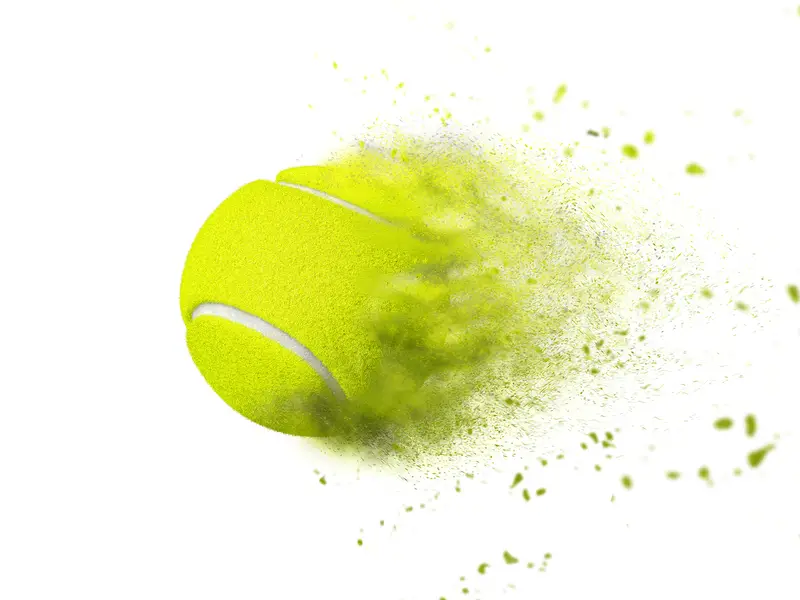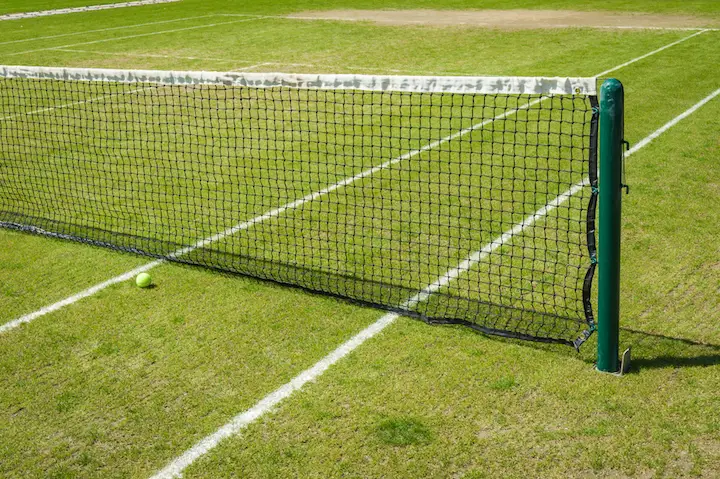- 26-27 PSI on average (pounds per square inch) – Regular Balls
- Cans of balls are also pressurized – hence the ‘POP’ when opening
- Pressure with other ball variations are significantly lower – green ball, orange ball, red ball
Your Guide
 Gavin Davison
Gavin Davison
If you’ve ever opened a BRAND NEW tin of tennis balls before, you’ll instinctively know that tennis balls (and their cans) are pressurized.
All sports balls are pressurized to a certain degree, however, and this is necessary FOR THEM to travel through the Air and Bounce.
Without this pressure, tennis balls would just hit the ground and roll, or barely bounce.
Armed with this knowledge, you could say that this is ONE OF the most important things in tennis!
The pressure has to be exactly right for optimal performance, and at the time of writing, there are around 200 ball varieties that have been approved by the ITF (International Tennis Federation).

I’d like to HIGHLIGHT something that people get confused about on this subject.
Perform a quick Google Search and you’ll see many resources CLAIMING that tennis balls are pressurized at around 12-14 PSI – not the 26-27 figure quoted above.
This is relative to the ACTUAL AIR PRESSURE we experience around us, not the pressure inside the ball itself.
Normal air pressure is somewhere between 14 and 15 PSI, on average, and when you add the 12-14 PSI for tennis balls to this, you arrive at the actual pressure within the tennis balls.
But let’s take things a STEP FURTHER now and look at why tennis balls are pressurized to this degree.
Why the pressure?
I’ve mentioned above that the air pressure within the balls is necessary to get them to BOUNCE and zip through the air. But this is a broad overview. There is a bit more to it than that, as detailed below.
Keep the Shape
That’s right – the nice, SPHERICAL SHAPE you see on a tennis ball doesn’t happen by chance.
Without the right air pressure inside, the ball would simply crumble into a heap of felt and rubber.
Of course, the FLIP SIDE of the coin is that should the air pressure within the ball be too extreme, the ball would start to bulge in various areas and you wouldn’t get a true bounce.
So as you can probably imagine, the pressure on all tennis balls needs to be perfect!
Extended Shelf Life
This is relative to the actual cans that tennis balls are stored in for sale.
I’ve talked about the ‘pop’ you get on tennis balls earlier, and this NOISE happens because the pressure inside of the can is then released.
Sure, the balls themselves are ALREADY PRESSURIZED during the manufacturing process, but the air pressure in the can needs to then match that of the balls to keep them in peak shape.
I’ve got to confess here, I FOUND THIS to be particularly interesting, and I didn’t know this before conducting my research.
Left inside the can, tennis balls can actually retain their pressure for years, even if they do lose pressure gradually OVER TIME.
So when you buy some balls, if you don’t plan on using them immediately, JUST KEEP THEM in the can and you can use them months or even years later.
Court Performance
Now we are getting to the actual knock-on effects of having this pressure once a game of tennis gets underway.
Since the 26-27 PSI within tennis balls is GREATER than the external air pressure, this means that the ball will react off the surface in a pretty LIVELY WAY.
This is what you want in a tennis ball, to be honest, as if the ball was somewhat dead or didn’t bounce too much, it would be tough to build a rally and ENJOY the game in general.
This holds true regardless of the surface you are playing on too. Sure, some courts are NATURALLY LIVELIER than others, and other factors like:
- Altitude
- Temperature
- And even court moisture can dictate how the ball responds.
But on the whole, using balls with this OPTIMUM PRESSURE is the best way to create a setting where you can play your best tennis.
It’s not just the bounce to think about here, however, it’s also the speed through the AIR and REACTION TO SPIN that is dictated by the ball’s internal pressure too.
A pressurized ball should zip through the air pretty QUICKLY, and when you’re hitting heavy topspin or slice, the ball should react to it well.
If not, it might be time to purchase some new balls!
Reaction From the Strings When Hit
Have you ever seen a slow-motion video of a tennis ball being struck?
When the ball hits the strings, the strings actually GIVE AWAY and FLEX to some extent, and the ball changes shape on contact.
That’s because the pressure inside of the ball is being given a shock on contact, but this is necessary for the ball to get that catapult reaction from the strings.
If the ball didn’t have enough pressure, it would compress to an EVEN GREATER extent and it certainly wouldn’t spring off the racket as desired.
Should the ball have too much pressure, however, it would feel like you are hitting a rock!
Trust me, I’ve used tennis balls in the past that were over-pressurized and it was AMAZINGLY DIFFICULT to control the ball – not what you want when trying to construct points or win a match!
Final thoughts
I sincerely hope that this article has provided you WITH THE ANSWERS you were looking for.
And for one final piece of advice, when you purchase tennis balls, make sure you do a QUICK TEST when you get them out of the can.
This can be done by squeezing the ball to ensure that it isn’t too soft, and by simply dropping the ball from waist or shoulder height.
A well-pressurized ball should BOUNCE UP to somewhere around your knee or higher – depending on the height you’ve dropped it from.
Should it not bounce up like this, you might have got your hands on some DUDS, and you are within your right to go and exchange them!
Have anything you’d like to add? Let us know in the comments.


